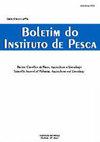不同食物管理策略下生物群落中太平洋白对虾的生产
IF 0.6
4区 农林科学
Q4 FISHERIES
引用次数: 0
摘要
本文分析了在生物群落系统中生产凡纳滨对虾(Litopenaeus vannamei)摄食率调整的不同模型。试验初始放养质量为4.21±0.09 g,放养密度为250只m-3,采用不同饲养方法放养60 d。第一种方法是根据Van-Wyk表,考虑最小(MIN)和最大(MAX)进料速率。第二种是根据饲料转化率(FCR)的两个估计值;FCR为1.1和1.5),基于Garzade Yta确定的方法。试验采用完全随机化设计,分为MAX、MIN、FCR 1.1和FCR 1.5 4个处理,4个独立重复。对该系统的动物技术性能、理化水质参数和固体产量进行了评价。使用表中确定的最低饲料量的处理显示出更好的饲料转化率和存活率,使用更少的饲料量,从而产生更少的废物。虽然使用表中最小值的投料策略效果较好,但由于Biofloc系统是一个具有变化的系统,必须根据系统的相互作用进行调整,因此仍有必要对这些策略进行改进。本文章由计算机程序翻译,如有差异,请以英文原文为准。
Production of pacific white shrimp in biofloc system with different food management strategies
In the present work, different models for adjustments in feeding rates to produce Pacific white shrimp (Litopenaeus vannamei) in a biofloc system were analyzed. Shrimps were stocked with an initial weight of 4.21 ± 0.09 g at a density of 250 shrimp m-3 and fed following different methodologies for 60 days. The first method was according to the Van-Wyk table, considering the minimum (MIN) and maximum (MAX) feed rates. The second was according to two estimated values from the feed conversion ratio (FCR; FCR of 1.1 and 1.5), based on the methodology determined by Garzade Yta. A completely randomized experimental design was adopted, consisting of four treatments (MAX, MIN, FCR 1.1, and FCR 1.5) with 4 independent replicates. Zootechnical performance, the physical and chemical water quality parameters, and the production of solids in the system were evaluated. The treatment that used minimum amounts of feed determined by the table showed a better feed conversion, survival, using a lower amount of feed and, thus, generating less waste. Although the feeding strategy using the minimum values in the table has shown better results, it is still necessary to improve these strategies, as the Biofloc system is a system that has variations and their adjustments must be made according to the interactions of the system.
求助全文
通过发布文献求助,成功后即可免费获取论文全文。
去求助
来源期刊

Boletim do Instituto de Pesca
FISHERIES-ZOOLOGY
CiteScore
0.80
自引率
0.00%
发文量
24
审稿时长
>12 weeks
期刊介绍:
To publish original articles of research and short communications in the following áreas: Fisheries, Aquaculture, Zootechnology, Limnology, Oceanography, Biology and Pathology of aquatic organisms. The publication depends on the approval of the Editorial Board, based on the peer review.
 求助内容:
求助内容: 应助结果提醒方式:
应助结果提醒方式:


